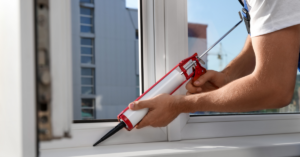The Dos and Don’ts of Caulking Windows

Caulking windows may not be glamorous, but it plays a crucial role in keeping your home comfortable and energy-efficient. Properly sealing gaps and cracks prevents drafts and keeps out moisture. In this blog post, we’ll explore the dos and don’ts, showing you how to do this without falling victim to any of the common mistakes.
The Dos
The first step is choosing the right caulk. For long-lasting results, use a silicone-based option. It offers excellent flexibility and durability, and will adhere well to a variety of materials. It also expands and contracts with temperature changes and resists water, making it perfect for sealing windows against whatever Mother Nature tosses its way.
Next, you’ll want to prepare the surface. Remove any dirt or peeling paint to achieve a smooth and effective bond. Cleaning and drying the window frame is crucial for the caulk to adhere well and create a tight seal.
Now, it’s time for the application. Follow these step-by-step instructions:
- Use painter’s tape to avoid time-consuming messes.
- Cut the caulk tube nozzle at a 45-degree angle for a controlled bead.
- Use a caulk gun to apply steady pressure, moving it smoothly along the gap for an even application.
This will give you an effective and professional-looking finish.
In addition to caulk, you’ll want to use weatherstripping around your windows sashes. This creates an airtight seal whenever the window is closed, providing an extra layer of protection against drafts in your home. This can help you reduce energy loss and lower your power bills.
The Don’ts
Don’t use the tube you found in the basement. Instead, start fresh. Caulk has a shelf life, and if it’s old, it might not properly adhere. This can reduce its effectiveness. So, be sure to check the expiration date. If it’s past its prime, replace it for optimal results.
Don’t caulk over existing caulk. Instead, carefully remove any old caulk to ensure a clean surface. This will help the new application adhere properly and create a tight seal, preventing leaks and drafts.
Large gaps shouldn’t be caulked without using a backer rod or foam fillers. Caulk isn’t capable of sealing large gaps by itself. If you see wide openings, use a backer rod or foam filler to pack the space partially first. This will help everything stay in place and provide better insulation.
Don’t forget to check for leaks. Over time, caulk may deteriorate or develop cracks, compromising its effectiveness. Regularly inspect your windows for any signs of leakage or damage. If you spot any issues, promptly fill the affected areas again in order to maintain a weatherproof seal.
Conclusion
Properly caulking windows is a simple yet effective way to enhance energy efficiency and weatherproof your home. By following the dos and don’ts outlined here you can successfully keep your home comfortable and protected from the elements for years to come. So, roll up your sleeves, grab that caulk gun, and get ready to seal those windows like a pro! Robey’s professionals are here to help you. If you have any questions, contact us today!
